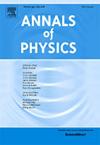Mapping Schwarzschild, de Sitter and anti-de Sitter spacetimes into flat spacetime systems with Kratzer potentials
IF 3
3区 物理与天体物理
Q2 PHYSICS, MULTIDISCIPLINARY
引用次数: 0
Abstract
This work investigates a method to map systems with gravitational fields into non-relativistic flat spacetime ones. Considering a line element of the form , we constructed an external potential in terms of the functions and . We found that the non-relativistic wave function is written in terms of the relativistic wave function. As applications, we constructed non-relativistic analogous models, introducing external potentials for two types of static and non-rotating black holes: Schwarzschild, anti-de Sitter, and de Sitter. Finally, we analyzed the physics at the event horizon region for the black holes and cosmological horizon for the de Sitter spacetime, and the values coincide with those obtained for the case with a gravitational field in the relativistic regime.
求助全文
约1分钟内获得全文
求助全文
来源期刊

Annals of Physics
物理-物理:综合
CiteScore
5.30
自引率
3.30%
发文量
211
审稿时长
47 days
期刊介绍:
Annals of Physics presents original work in all areas of basic theoretic physics research. Ideas are developed and fully explored, and thorough treatment is given to first principles and ultimate applications. Annals of Physics emphasizes clarity and intelligibility in the articles it publishes, thus making them as accessible as possible. Readers familiar with recent developments in the field are provided with sufficient detail and background to follow the arguments and understand their significance.
The Editors of the journal cover all fields of theoretical physics. Articles published in the journal are typically longer than 20 pages.
 求助内容:
求助内容: 应助结果提醒方式:
应助结果提醒方式:


